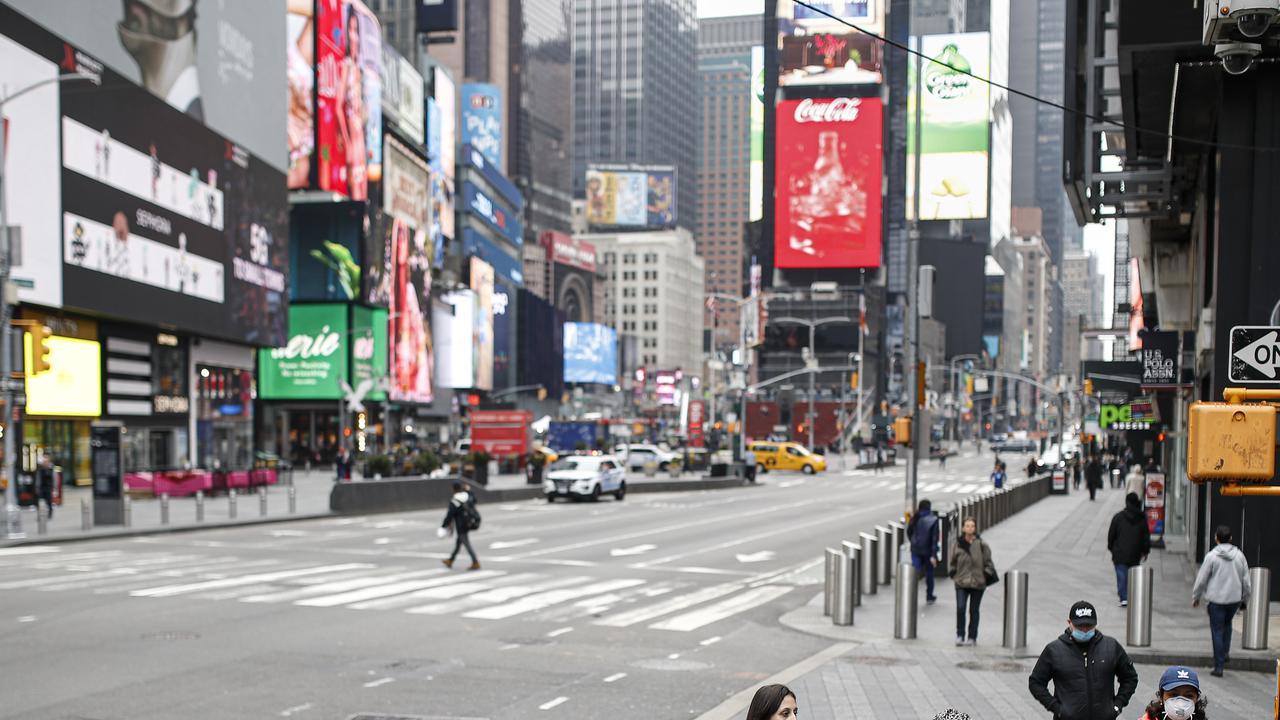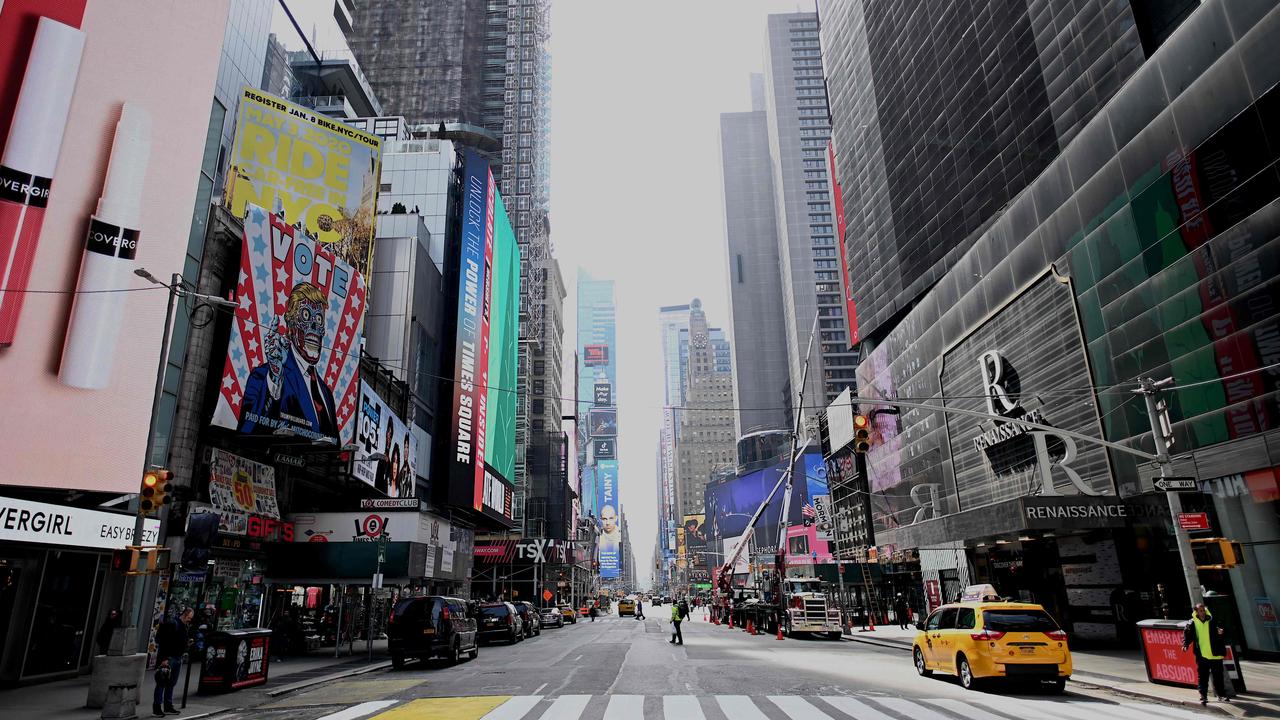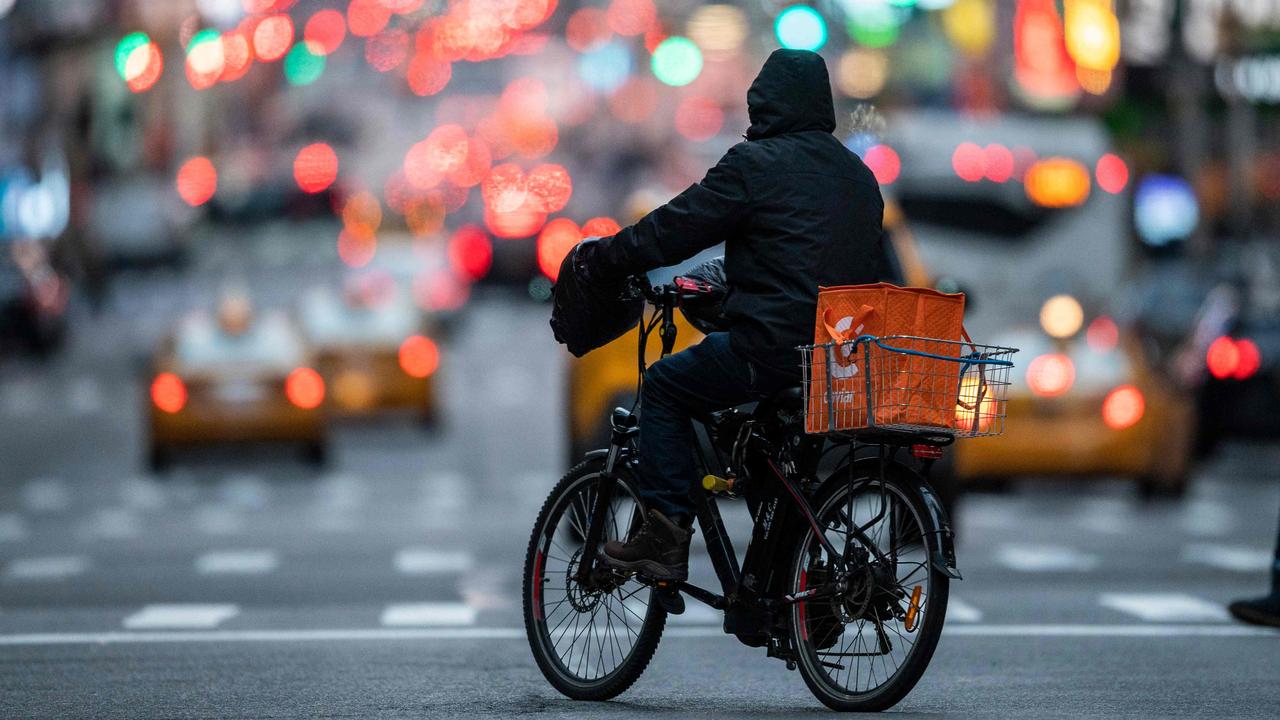Coronavirus: New York and other US states forced to lockdown
New York has been forced into lockdown, joining California and other US states, as Americans are warned to “prepare for the worst and hope for the best”.

The US is buckling under the strain of the coronavirus pandemic as its major cities shut down, lives and jobs are lost, and people are warned to “prepare for the worst and hope for the best”.
New York governor Andrew Cuomo dramatically ramped up Empire State’s coronavirus shutdown Friday, ordering a statewide lockdown that will see the lights go out on all non essential businesses, including those in New York City by 8pm on Sunday.
“We’re going to take the ultimate step which is to close the valve … New York State (is going) on pause,” Mr Cuomo said, as the state’s cases soared to 7,100 on Friday, with more than 4,400 cases in the Big Apple.
“I want to be able to say to the people of New York — I did everything we could do.
“And if everything we do saves just one life, I’ll be happy.”
RELATED: Follow the latest coronavirus updates


The executive order will force all non-essential businesses across the state to close, leaving just grocery stores, pharmacies and other essential operations open.
Group outdoor activities, including basketball games and other team sports will be banned along with all gatherings of any size, in the state of over 19 million people.
#BREAKING: I will sign an Executive Order mandating that 100% of workforce must stay home, excluding essential services.
— Andrew Cuomo (@NYGovCuomo) March 20, 2020
This order excludes pharmacies, grocery stores, and others.
NY has a critical need for Personal Protective Equipment (PPE) including gloves, gowns and masks — as well as ventilators.
— Andrew Cuomo (@NYGovCuomo) March 20, 2020
If you have or can make any of these supplies, New York is buying. Please email COVID19supplies@esd.ny.gov.
Help us share this far and wide! pic.twitter.com/ButFM0D3bD
Essential services businesses: Make sure to implement and follow social distancing rules. pic.twitter.com/Wr9udL52C9
— Andrew Cuomo (@NYGovCuomo) March 20, 2020
All non-essential government and private sector employees will be required to work from home. Employees in essential services will be allowed to continue working in grocery stores, pharmacies, and healthcare, Mr Cuomo said.
“This could be going on for months,” the governor added.
“Stay in your apartment for two, three, four months, that is frightening.
“We need everyone to be safe – otherwise, no one can be safe.
“Only essential businesses will function.”
Public transit will continue to operate in the foreseeable future.
Mr Cuomo said the orders will be strictly enforced and businesses in violation will be fined.
The governors of New Jersey, Connecticut and Pennsylvania issued similar edicts.
“This is not life as usual,” Mr Cuomo said.
“Accept it, and realise it, and deal with it.”
Mr Cuomo, who has been pushing the government to accelerate the production of protective equipment and ventilators, said “state is shopping for ventilators” as thousands of Americans succumb to the respiratory illness.
“We literally have people in China shopping for ventilators which is one of the largest manufacturers,” he said.

‘PEOPLE ARE GOING TO DIE WHO DON’T HAVE TO’
In an MSNBC interview on Friday morning, New York mayor Bill De Blasio said the country was “running out of options in many places – and New York is really the front line of this battle right now”.
“A lot of people are going to die who don’t have to die,” he said.
“That is the blunt truth. And it will start with dozens and it will go to hundreds and it will go farther than that when you talk about this country.
“People who will die waiting to get into a hospital, people who will die at a hospital because there is no equipment or there’s no medical personnel who can help them in time.”
The mayor told CNN the city could run out of medical supplies in two weeks, as the total number of cases confirmed nationwide exceeds 13,678, with the total number of deaths past 200.
“We are now, whether we would like it or not, we are the epicentre,” he said on Friday.
New York State now has the highest number of cases than another state in the country.
LIVE: Press Briefing with Coronavirus Task Force https://t.co/km5CdvLvGG
— The White House (@WhiteHouse) March 20, 2020
New York acted after California on Friday ordered its 40 million residents to stay at home in the nation’s biggest lockdown as part of a desperate bid to slow the spread of the disease. Illinois planned to issue a similar order later in the day, according to two government officials who spoke on condition of anonymity ahead of the governor’s announcement.
“We’re planning for the worst and hoping for the best,” Mr Cuomo said.
“This is about saving lives.”
The increasingly drastic measures in the US came as gasping patients filled the wards of hospitals in Spain and Italy, and the global death toll surpassed 11,000, with the virus gaining footholds in new corners of the world. Italy, the hardest-hit country in Europe, reported 627 new deaths Friday, its biggest day-to-day rise since the outbreak began, and said new cases also shot up. Italy now has seen over 4,000 deaths - more even than China - and 47,000 infections.
The World Health Organisation noted the epidemic’s dramatic speed, pointing out that it took more than three months to reach the first 100,000 confirmed cases but only 12 days to reach the next 100,000. As of Friday, Johns Hopkins University counted more than 260,000 infections worldwide.
TRUMP BLOWS UP AT REPORTER OVER VIRUS QUESTION

In a press conference with the coronavirus task force on Friday local time, Mr Trump briefed reporters at the White House about the latest on the fight to combat the virus.
The US President said he “felt good” about drug therapies being tested as possible treatments for the virus and that the federal government had already ordered “millions of units” of them.
Mr Trump’s comments came after his director of the National Institute of Allergy and Infectious Diseases, Anthony Fauci, made clear that any evidence about any effective treatments being discovered was strictly “anecdotal” and not the product of a “clinical trial”.
“You really can’t make any definitive statement about it,” Dr Fauci said.
Moments earlier, Dr Fauci was asked whether there was any evidence that one such drug — hydroxychloroquine — might be used as an effective prophylactic measure against coronavirus.
“The answer is no,” Dr Fauci replied.
NBC News’ Peter Alexander, a White House correspondent and a weekend anchor of “TODAY,” then asked Mr Trump whether his “positive spin” regarding the potential treatments was giving Americans false hope.
“Is it possible that your impulse to put a positive spin on things may be giving Americans a false sense of hope?” Mr Alexander asked.
“No, I don’t think so,” Mr Trump replied.
“It may work, it may not work.
“I feel good about. That’s all it is, it’s a feeling.”

Mr Alexander then asked the US President to offer a reassuring message to the nation.
“What do you say to Americans who are scared? I guess, nearly 200 dead, 14,000 who are sick, millions, as you witnessed, who are scared right now,” he asked.
“What do you say to Americans who are watching you right now who are scared?”
But Mr Trump didn’t take kindy to the question.
“I say that you’re a terrible reporter,” Mr Trump said.
“That’s what I say. I think that’s a very nasty question
“The American people are looking for answers and they’re looking for hope, and you’re doing sensationalism.”
Mr Trump added that the US should “see if it works”, referring to possible treatments.
“It might and it might not,” he said,
“I happen to feel good about it, but who knows, I’ve been right a lot. Let’s see what happens.”
Mr Trump continued to hurl insults at Mr Alexander later in the news conference, using a question from another reporter to levy an additional attack on him.
Mr Trump was asked if he felt “going off on Peter” was “appropriate when the country is going through something like this”.
“I do,” the president replied.
“I’ve dealt with Peter for a long time.
“And I think Peter is not a good journalist.”



